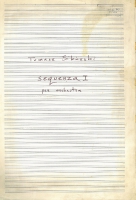Sequenza I per orchestra (1966)
The first mature period in Tomasz Sikorski’s work can be described as ‘sonorist’. Works characteristic of it include Sequenza I. Completed in 1966, the composition is typical of many pieces written in Poland at the time in its use of a broad palette of orchestral colours, organisation of the musical material into sound blocks and use of novel articulation techniques. The premiere, featuring the RAI orchestra from Turin conducted by Andrzej Markowski, took place during the Warsaw Autumn Festival in September that year.
The programme booklet contains a rather perfunctory commentary by the composer:
Sequenza I. A single-movement work for orchestra. Scoring: traditional symphony orchestra. Duration: 9’. Sequenza I consists of several sound fields the structure of which is a result of individual playing of the various instruments or instrumental groups.
The composer achieves this ‘sound field’ effect by giving up vertical synchronisation throughout the piece except for the entries and ends of the modules. They are filled with patterns – separate for each instrumental part and repeated irregularly – the duration of which falls within a specific time range. The ‘fields’, on the other hand, are clearly delineated by means of numerous general pauses.
This is what Ewa Grosman says about Sikorski’s composition:
Sequenza I is both rich and economical when it comes to sound. Its richness lies in a colourful variety of the various fragments of the score and in the inner mobility (of varying intensity) of seemingly static sound structures. The economy, in turn, is manifested in a limitation of technical means and use of vast sound planes, which are far from dazzling the listeners with sonic sumptuousness.
The work got good reviews and Tomasz Sikorski began to be seen as a mature and original artist. Jerzy Jaroszewicz wrote, for instance, in Ruch Muzyczny:
Sequenza I is a work that has a lot in common with Tomasz Sikorski’s previous compositions. Prologues (and even Echoes), Concerto Breve, finally Sequenza I – they all make up a continuous stylistic line: the pieces not only have a similar structure, but also share the way the sound material is selected; their essence is observation of sound in itself, observation equally distant from expansiveness and from contemplation. All these characteristics constitute what could probably be called the style of the composer, who is looking for his own form of shaping objective music. We may like it or not, but we should certainly appreciate it, if only because of the fact that neither is it an easy way out nor does it kowtow to fashion or snobbery.
A few years after the premiere the composer prepared the piece for publication. However, the published version is different from the premiere version. The most important difference is a lack of an extensive violin fragment at the beginning of the piece, a fragment that constitutes about a half of the section marked in the first version of the score with letter A and the entire section B. The changes also affect a number of details throughout the work. However, Sequenza I was never performed in its new version.

